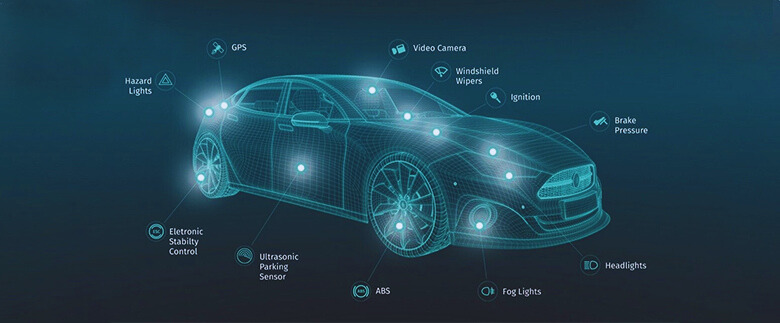Introduction:
In today’s fast-paced world, safety on the road is more important than ever. With advances in technology, modern vehicles come equipped with a wide range of safety features that can help protect you, your passengers, and even other road users. Whether you’re buying a new car or upgrading your current vehicle, understanding these features is crucial for making informed decisions.
In this comprehensive guide, we will explore the essential car safety features to consider in 2024. From active safety systems that prevent accidents to passive safety features that protect you in case of a collision, we’ll cover everything you need to know.
1. Anti-lock Braking System (ABS)
One of the most well-known safety features, ABS is designed to prevent your car’s wheels from locking up during heavy braking. This feature ensures that you maintain steering control, which can help you avoid obstacles while braking. ABS is especially important on slippery surfaces like wet or icy roads.
Why ABS Matters:
- Prevents skidding: ABS reduces the risk of skidding during emergency braking.
- Enhances control: Allows you to maintain steering control while braking.
- Reduces stopping distance: In some cases, ABS can shorten the distance needed to bring your car to a halt.
2. Electronic Stability Control (ESC)
Electronic Stability Control is another critical Car Safety feature that works in conjunction with ABS. ESC helps to prevent loss of control by automatically applying brakes to individual wheels when it detects skidding or loss of traction. This feature is particularly helpful in emergency maneuvers or during sharp turns.
Why ESC is Crucial:
- Prevents rollovers: ESC reduces the likelihood of rollover accidents.
- Improves stability: It helps keep your car stable on slippery roads.
- Mandatory in many regions: ESC is now required in new vehicles in many countries due to its effectiveness in preventing accidents.
3. Airbags
Airbags are a passive Car Safety feature designed to protect passengers in the event of a collision. Modern cars come equipped with multiple airbags, including front, side, curtain, and even knee airbags. These inflatable cushions absorb impact energy and reduce the severity of injuries.
Types of Airbags:
- Front airbags: Deployed from the steering wheel and dashboard during front-end collisions.
- Side airbags: Protect occupants during side-impact crashes.
- Curtain airbags: Deploy from the roof to cover side windows, offering head protection.
- Knee airbags: Provide additional protection for the legs in the event of a frontal collision.
Why Airbags Are Essential:
- Reduces fatality risk: Airbags can significantly reduce the risk of fatal injuries in severe crashes.
- Cushions impact: Helps to distribute the force of impact and protect vital areas like the head and chest.
4. Lane Departure Warning and Lane Keep Assist
Lane Departure Warning (LDW) and Lane Keep Assist (LKA) systems are designed to help prevent unintended lane changes. LDW alerts the driver if the car is drifting out of its lane without signaling, while LKA automatically steers the car back into its lane if it begins to drift.
Key Benefits:
- Prevents accidents caused by drowsiness or distraction: Both systems help avoid accidents by keeping drivers aware and in control.
- Supports long-distance driving: These features are particularly helpful during long drives where fatigue may set in.
5. Blind Spot Monitoring
Blind Spot Monitoring (BSM) systems use sensors to detect vehicles in your blind spots and alert you through visual or auditory signals. This feature can be a lifesaver when changing lanes or merging onto highways.
Why You Need Blind Spot Monitoring:
- Enhances situational awareness: Detects vehicles in areas you can’t easily see.
- Reduces lane-change collisions: Alerts help you make safer lane changes.
- Ideal for highway driving: Useful when driving at high speeds where quick lane changes are common.
6. Adaptive Cruise Control (ACC)
Adaptive Cruise Control goes beyond traditional cruise control by adjusting your car’s speed based on the flow of traffic. Using radar and cameras, ACC maintains a safe distance from the vehicle in front of you, automatically slowing down and speeding up as necessary.
Key Advantages:
- Reduces driver fatigue: Especially helpful on long highway journeys, as ACC manages your speed for you.
- Improves fuel efficiency: By maintaining a steady speed, ACC can contribute to better fuel consumption.
- Supports safe driving: Helps maintain a safe following distance, reducing the risk of rear-end collisions.
7. Forward Collision Warning and Automatic Emergency Braking
Forward Collision Warning (FCW) and Automatic Emergency Braking (AEB) are two interconnected systems designed to prevent or mitigate front-end collisions. FCW alerts the driver of an impending crash, while AEB automatically applies the brakes if the driver fails to react in time.
Why These Features Are Game-Changers:
- Prevents crashes: AEB can reduce or completely avoid rear-end collisions by braking automatically.
- Protects pedestrians: Some systems also detect pedestrians, applying brakes to avoid hitting them.
8. Rearview Camera and Parking Sensors
Reversing and parking can be challenging, but rearview cameras and parking sensors make these tasks much easier and safer. The rearview camera displays what’s behind your vehicle, while parking sensors detect nearby objects and alert you to potential hazards.
Benefits of These Features:
- Reduces the risk of back-over accidents: Helps prevent accidents with pedestrians, cyclists, or other vehicles.
- Easier parking: Makes parallel parking and tight spots easier to navigate.
- Increased Car Safety for children and pets: Rearview cameras make it easier to spot small children or animals behind your car.
9. Tire Pressure Monitoring System (TPMS)
Maintaining proper tire pressure is crucial for both Car Safety and fuel efficiency. A Tire Pressure Monitoring System (TPMS) alerts you when one or more of your tires are under-inflated, reducing the risk of blowouts and improving fuel economy.
Why TPMS is Important:
- Prevents accidents due to tire failure: Low tire pressure can lead to blowouts, causing loss of control.
- Improves fuel efficiency: Properly inflated tires can improve your car’s gas mileage.
- Prolongs tire life: Maintaining the correct tire pressure helps to extend the life of your tires.
10. Traction Control System (TCS)
Traction Control Systems (TCS) prevent your wheels from spinning out of control by automatically adjusting power delivery to the wheels when slip is detected. This feature is especially useful in low-traction situations, such as driving on snow or wet roads.
Why TCS is a Must-Have:
- Improves grip: Provides better traction on slippery surfaces.
- Reduces wheel spin: Helps you maintain control during acceleration.
- Essential for bad weather: Particularly valuable in rain, snow, or ice conditions.
11. Pedestrian Detection
Pedestrian Detection systems use cameras and sensors to detect pedestrians in your car’s path. If a collision is imminent, the system will alert the driver or automatically apply the brakes to avoid or minimize the impact.
Why Pedestrian Detection is Key:
- Increased urban safety: Reduces the risk of accidents in crowded city environments.
- Saves lives: Automatic braking can prevent fatal pedestrian accidents.
12. Driver Attention Monitoring
Driver Attention Monitoring systems use cameras and sensors to track signs of driver fatigue or distraction. If the system detects that the driver is not paying attention or is too tired, it will alert them to take a break or refocus on the road.
Benefits of Driver Attention Monitoring:
- Prevents accidents caused by fatigue: Keeps you alert during long drives.
- Improves driver safety: Reduces the risk of accidents caused by distraction or drowsiness.
13. Cross-Traffic Alert
Cross-Traffic Alert systems help you avoid collisions when reversing out of parking spaces by detecting approaching traffic from either side. This feature is especially useful in busy parking lots or when your view is obstructed.
Why Cross-Traffic Alert is Useful:
- Prevents parking lot accidents: Alerts you to cars, bikes, or pedestrians when reversing.
- Increases safety in tight spaces: Ensures you’re aware of moving objects outside your field of view.
Conclusion: Prioritize Safety for a Smarter Drive
When shopping for a car in 2024, it’s essential to consider these safety features. While some of these technologies may seem like luxuries, they can significantly enhance your safety and peace of mind on the road. Prioritize features like ABS, ESC, airbags, and more advanced systems like Adaptive Cruise Control and Pedestrian Detection to ensure that your vehicle is equipped to protect you and others.
Always remember that while technology can assist in preventing accidents, safe driving habits are equally important. Make sure to stay alert, avoid distractions, and follow traffic rules to get the most out of your car’s safety features.








